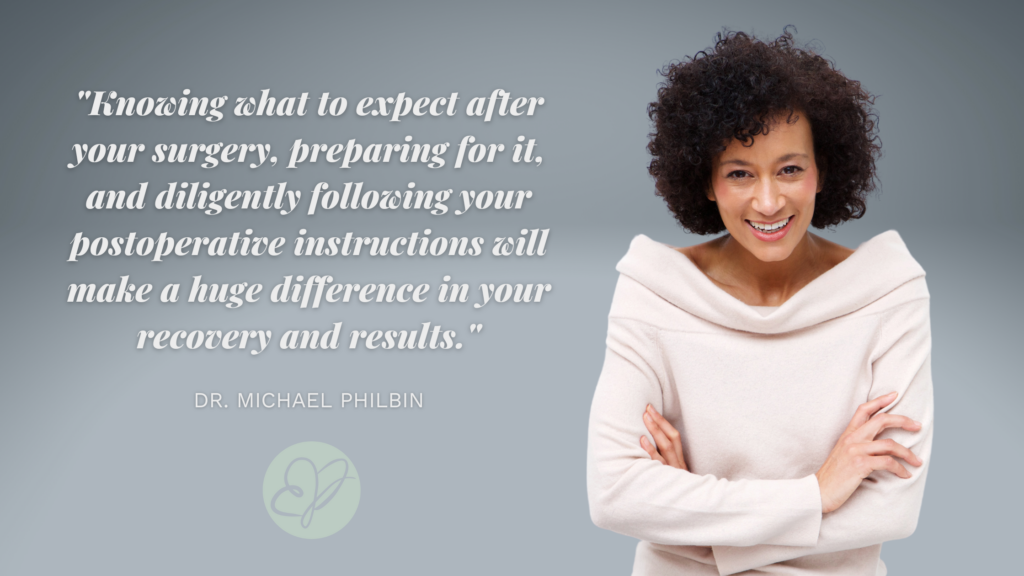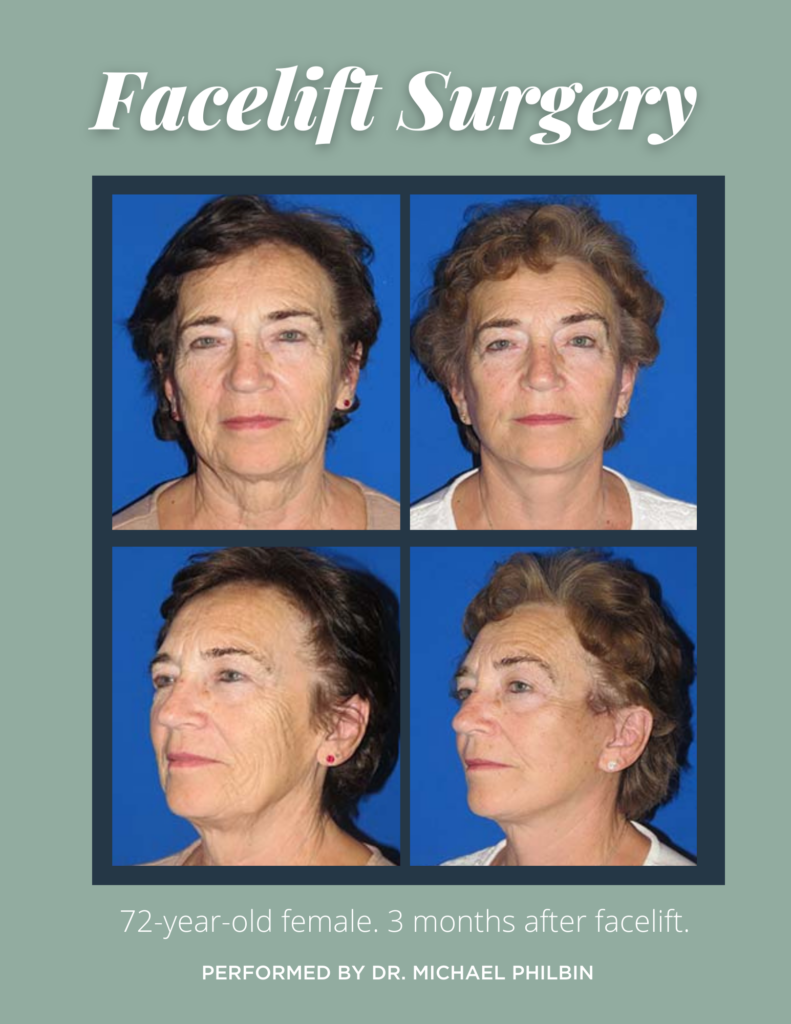According to the Inaugural American Society of Plastic Surgery (ASPS) Insights and Trends Report, facelift surgery was the second most popular surgery in 2022, behind liposuction. That means thousands of women and men went under the knife that year to achieve the fresher, more youthful-looking appearance that facelift surgery can deliver. If you are considering a facelift, your education must go beyond just what the surgical procedure entails. Understanding the protocols and details of your recovery are equally important and may even help you optimize your results and see them sooner!
“Every patient has a unique experience with their recovery from facelift surgery or any surgery for that matter,” explains Dr. Michael Philbin, a board-certified plastic surgeon and partner at Edina Plastic Surgery. “Countless variables factor into how someone will recover from a facelift, including the patient’s age, current health status, and lifestyle factors such as smoking, proper nutrition, and prior skincare habits. Knowing what to expect after your surgery, preparing for it, and diligently following your postoperative instructions will make a huge difference in your recovery and results.”
Week One of Your Facelift Recovery
“During the first week after your facelift surgery, it is vital that you follow postoperative instructions on how to care for your incisions and to keep them clean to prevent infection,” stresses Dr. Philbin.
Day 1 – Upon waking from anesthesia after your surgery, you will most likely be very sleepy and groggy. It’s essential to have your entire support team set up and ready to go well before your surgery day to ensure you have someone to drive you home and take care of you that first night. Most patients require the prescribed pain medications given to them on this day to ease discomfort.
“About two hours after your facelift surgery, your surgeon will examine you to prepare for your discharge,” says Dr. Philbin. “Our recovery nurse will ensure that your caregiver understands the postoperative care instructions. You will wear a large head dressing overnight. In rare instances, an overnight hospital admission could be required to monitor the first night of recovery.”
“In addition to having a trusted friend or relative with you on the day of your facelift surgery, there are some other preliminary steps you can take to ensure that your recovery is headed in the right direction,” advises Dr. Philbin. “We refer to this particular preparation as a ‘recovery station.’ It consists of gathering essential items you will need during your recovery and placing them near (preferably within arm’s reach) where you will be resting. Having items like electronics, chargers, remotes, books, magazines, snacks, drinks, medications, or other little things can help maximize your recovery time and keep you from feeling too stir-crazy in those first couple of weeks!”
Day 2 – “You will most likely see your plastic surgeon the day after your facelift surgery for a follow-up,” says Dr. Philbin. “At this appointment, your surgeon or nurse will remove your drains and ensure your recovery is on track. While no bandages are usually required, you will look bruised and swollen. Your surgeon will provide specific instructions regarding activity guidelines and when you can return to work – most likely in two to three weeks after surgery.”
Day 3 – Rest is an integral part of recovery and is not to be underrated. Although many patients start to feel markedly better and more alert by day three, it is imperative that you rest with your head elevated. Bruising and swelling usually peak around day three and four after facelift surgery, but anticipate that they will remain for several weeks before fully resolving. Some patients may discontinue using stronger pain medications at this time and transition to Motrin or Tylenol, but it’s important to continue use if heightened discomfort is still present.
Days 4 to 7 – “Many patients turn a big corner at the end of the first week following facelift surgery,” says Dr. Philbin. “Some downgrade their pain medications to over-the-counter options, while others find they need very little pain management at all. This is the time that we usually start to see a marked decrease in swelling, and bruising begins to lighten. Sutures are also commonly removed around one week post-surgery, depending on how a patient is healing. Although rest is still crucial at this stage, patients are encouraged to get up and move around through their home to increase blood flow and encourage lymphatic drainage of tissues.”
Week Two of Your Facelift Recovery
Days 8 to 14 – Expect some swelling and light bruising to still be present at this stage of your recovery from facelift surgery. In addition, some patients may experience mild tightness, tingling, itching, and even numbness. These are all common and temporary sensations, but be sure to share any concerns with your plastic surgeon.
By the end of the second week following facelift surgery, most patients start to feel like themselves again. Light activities around the house and walking outdoors are allowed and recommended to encourage blood flow. Many patients also plan to return to work during or after the second week after facelift surgery, as any residual bruising is easily covered by makeup, and swelling is significantly reduced.
Weeks Three and Four After Your Facelift Surgery
Days 15 to 30 – “Depending on the patient, which procedures they may have had performed with their facelift, such as blepharoplasty, and their individual healing process, sutures from facelift surgery are generally removed around the end of week one to week three,” says Dr. Philbin. “This is, of course, an exciting time for patients! Around weeks three and four, you may still experience a little swelling and tightness on your face, but you should feel and look much more like yourself and be able to see some of your results setting in.”
The third and fourth weeks after facelift surgery are also when most patients are allowed to return to their daily activities and exercise regimen. Any outward signs of your procedure are easily covered by makeup or hats. Incision sites may still appear slightly pink, but this will fade with each passing week. Patients must wear an SPF 30 or higher when outdoors to prevent darkening pigmentation on any scars.
What To Expect the First Month After Your Facelift Surgery
“You should be back to your normal life one month after your facelift surgery for the most part, except you’ll have a fresh, younger-looking appearance to face the world with,” says Dr. Philbin. “Remember that it may take up to a full year for all minor swelling, bruising, tightness, and numbness to fully subside. But rest assured that most of these symptoms are only noticed by you and not visible to those around you.”
“I also stress to patients that your individual timeframe for recovery after facelift surgery is unique to you,” explains Dr. Philbin. “Just because your girlfriend had a short recovery doesn’t necessarily mean that you will and vice versus. Remember that your recovery depends highly on how closely you adhere to post-op instructions, how much your rest, what your diet consists of, and the condition your skin and health were in before your surgery.”
“Recovery from facelift surgery is a journey that you take with your plastic surgeon, so it is important to keep lines of communication open with us in the weeks leading up to and following your surgery,” stresses Dr. Philbin. “We’re your partners in this, and we have just as much invested in wanting you to achieve incredible results that elevate your confidence and improve your life!”
Have you been considering facelift surgery? Scheduling a complimentary consultation to discuss this procedure with Dr. Michael Philbin or another board-certified plastic surgeon at Edina Plastic Surgery by calling (612) 688-3177, texting (952) 925-1765, or CLICKING HERE.




